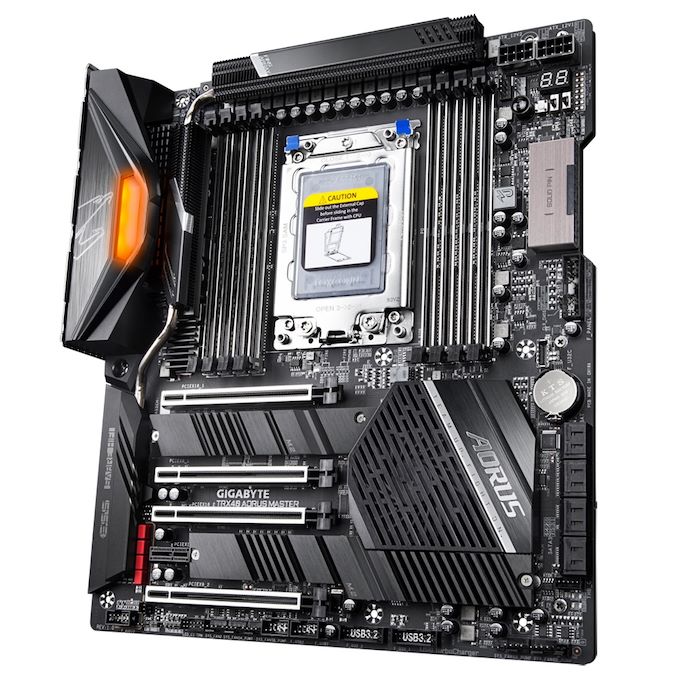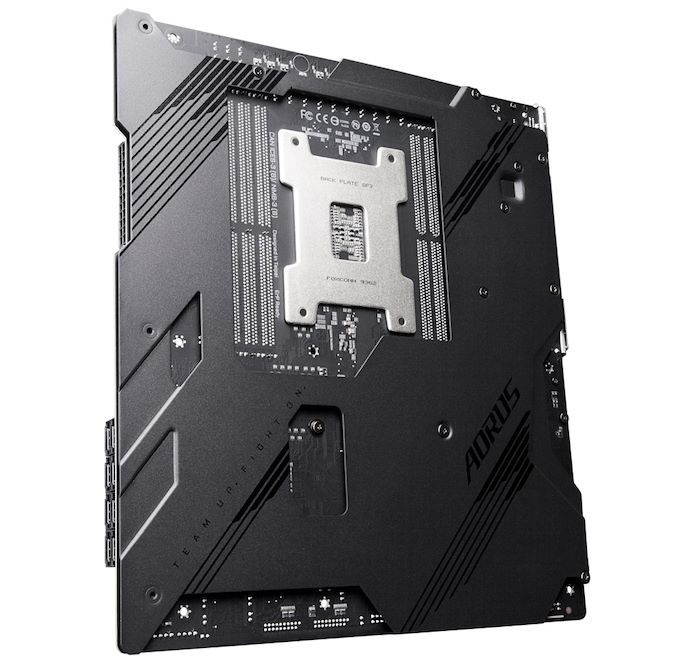The AMD TRX40 Motherboard Overview: 12 New Motherboards Analyzed
by Gavin Bonshor on November 28, 2019 9:00 AM EST- Posted in
- Motherboards
- AMD
- MSI
- Gigabyte
- ASRock
- Asus
- TRX40
- Threadripper 3000
- Castle Peak
GIGABYTE TRX40 Aorus Master
The GIGABYTE TRX40 Aorus Master sits below the TRX40 Aorus Xtreme in the product stack and combines a similar style, in a slightly smaller, but still larger than normal E-ATX PCB. Still retaining the high-end feel, the TRX40 Master is using an E-ATX PCB which is crammed with good quality controllers. The most notable features include support for DDR4-4400 and 256 GB, a pair of Ethernet ports on the rear panel including an Aquantia 5 G controller, Intel's AX200 Wi-Fi 6 wireless interface, and a beefy 16-phase CPU power delivery.
Starting from the top, the GIGABYTE TRX40 Aorus Master has eight memory slots in two banks of four on either side of the sTRX4 socket with support for DDR4-4400 and up to 256 GB in total. Taking a slightly more basic approach to the aesthetics, the rear panel cover does include integrated RGB LEDs, with black heatsinks on a black PCB. The large black aluminium power delivery heatsinks which are interconnected via a heat pipe are cooling a 16-phase power which consists of an Infineon XDPE132G5C 16-phase PWM controller, with sixteen Infineon TDA21472 70 A power stages. Providing power to the CPU is two 8-pin 12 V ATX power connectors which are located in the top right-hand corner.
Also at the top right-hand corner of the board is a two-digit LED debug, while below this is a right-angled 24-pin motherboard power connector. For PCIe devices, there are four full-length PCIe 4.0 slots which operate at x16/x8/x16+x8 and a single PCIe 4.0 x1 slot. The TRX40 chipset heatsink is actively cooled just as we saw with X570. For storage, the GIGABYTE TRX40 Aorus Master has three PCIe 4.0 x4 M.2 slots which include M.2 heatsinks for each slot, and there are eight SATA ports with support for RAID 0, 1, and 10 arrays.
Like with the GIGABYTE TRX40 Aorus Xtreme, the TRX40 Aorus Master also includes a large black metal backplate which will add extra weight to the board. The backplate displays the motto 'Team Up, Fight On' which is more of a gaming term, which is understandable given the boards Aorus branding. The TRX40 Aorus Master includes dual BIOS with a switch which allows users to select between the two, and for cooling, there is a total of eight 4-pin headers. These are split into one for a CPU fan, one dedicated for a water pump, and six for chassis fans.
On the rear panel are five USB 3.1 G2 Type-A, one USB 3.1 G2 Type-C, and two USB 2.0 ports. There are two Ethernet ports with one controlled by an Aquantia 5 G, and the other by an Intel Gigabit Ethernet controller. This model also includes Intel's AX200 Wi-Fi 6 wireless interface and also adds BT 5.0 connectivity too. To the left-hand side is a Clear CMOS and Q-Flash Plus switch, with the five 3.5 mm audio jacks and S/PDIF optical output handled by a Realtek ALC4050H and Realtek ALC1220 audio codec pairing. The TRX40 Aorus Master also includes a Realtek ALC4050H and ESS Sabre 9218 DAC for the front panel audio.
The GIGABYTE TRX40 Aorus Master is still a high-end TRX40 motherboard and with an MSRP of $499, it isn't exactly cheap, but it does offer users plenty of good quality features on AMD's new HEDT platform. While the Aorus brand is mainly targeted at gamers, the TRX40 Aorus Master looks to combine elements from both the enthusiast and gaming sides, to create a reasonably priced multi-purpose model for all looking to use and unlock all of the power within the Threadripper 3000 processors.













109 Comments
View All Comments
HJay - Saturday, November 30, 2019 - link
Life really does begin at 50.HJay - Saturday, November 30, 2019 - link
Your point is valid and I'm not ready to switch from external interfaces to an internal RME unit yet. However, the performance and quality of the peculiar on-board audio arrangement is still of great interest. Experiencing AMD's AM3 FX chipset USB implementation (See: "Silicon Errata for SB950") was rather eye opening and very helpful in understanding why running USB audio across that implementation was less than optimal. The USB arrangement of AM4 seems to be an improvement over the AM3 and AM3+. But AMD's TRX40 seems to reveal a non-satisfactory level of concern for PC audio -suggesting that AM4 might be more appropriate. This motherboard review is a great start but there are still many holes to fill in regarding this, in particular with the S1220.Selecting an appropriate motherboard upfront before throwing thousands of dollars worth of audio software and hardware at it is critical. I did note compatibility issues between earlier AM4 systems and some Universal Audio cards and the desired RME card is around $900. So, I'm just not ready to ride the bleeding edge with these new boards but will eagerly listen to the experiences of others and cheer them along.
As a side note, I did recommend to my favored audio repair software vendor that they contact AnandTech to provide, or work out, some audio benchmarking tests or packages.
Bccc1 - Saturday, November 30, 2019 - link
I still don't get your point. I agree that the USB implementation is important, that AMD messed that up in the past (thanks for the ref to the errata list) and that the way onboard audio works on TRX40 is maybe more error prone.But why is that different / better with the S1220? And how do you define an audio creator? I was thinking of an audio engineer, someone who does tracking/mixing/mastering/sound design. I can't imagine someone in that field would ever use onboard audio, except maybe for mobility reasons on a notebook.
I will probably use my RME Madiface XT with a StarTech USB card (PEXUSB3S44V) as I don't trust any onboard USB.
Regarding the compatibilty issues, do you have links/detailed information? The only thing I found was an issue, where the card wasn't detected in PCIe slots connected to the chipset. Which is a shame, but less of a problem with TRX40 as most slots are directly connected to the CPU.
tamalero - Saturday, November 30, 2019 - link
I'm no expert here but could perhaps say this because of the audio problems of some cpus (crackling cutting) because of the high latency of Ryzen and the first Threadrippers?Or perhaps power issues (delivery to PCIE ports because the big power consumption of the new TR chips?)
Dug - Saturday, November 30, 2019 - link
I think it's time to move past USB if you are a "Real content creator"valinor89 - Friday, November 29, 2019 - link
"The TRX40 chipset is based on the 14 nm process node from Global Foundries""AMD leveraged GlobalFoundries 12nm to build the TRX40 chipset"
Is it 12 or 14?
tamalero - Saturday, November 30, 2019 - link
I remember that Global Foundries is 14nm while TSCM is 14+ (12nm)gavbon - Monday, December 2, 2019 - link
I have corrected it, it is Global Foundries 14 nm process. Thank you for the heads upscineram - Wednesday, December 4, 2019 - link
That's not what Ian said.PopinFRESH007 - Sunday, December 29, 2019 - link
I believe what Ian was referring to is the IO chip on the CPU package which is 12nm.